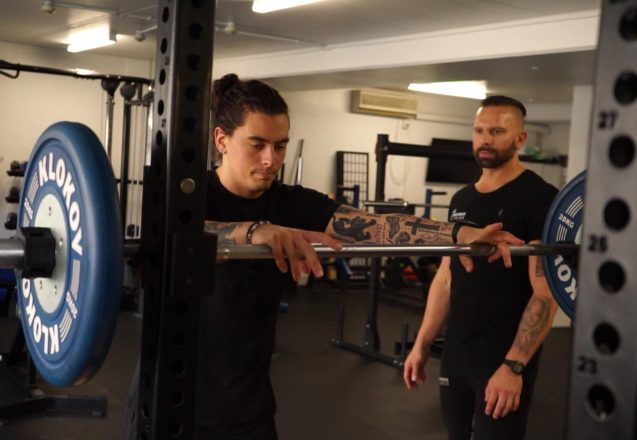Strength Training for the Beginner
In this article we are going to be talking about the best Strength Training for the Beginner. “The best workout program is the one you’re not using.” is a motto in which there is some wisdom, even though the design of a workout program is not very simple. There are many early studies regarding weight training that have attempted to find out the best single program for set/rep training. “There can only be one” is what is said in the Highlander series.
One example is Arnold Schwarzenegger’s 5×5 method that was has made popular by his mentor Reg Park, who was himself a Mr, Universe, and played the role of Hercules in the movies. Reg Park was the first bodybuilder who was able to bench press 500 pounds, and was as strong as he appeared to be.
In 1981, Mike Stone and his other colleagues published a study that suggested that it is best to combine protocols instead of concentrating on one protocol for strength training. In this study, “A Hypothetical Model for Strength Training”, there was a transition in the workouts from low intensity/high reps with fewer sets or high volume to high intensity/low reps and more sets or low volume. This was based on on a model that was published in 1954 by Leonid Matveyev, a Russian sports scientist, as a popular periodization model. The end aim of this was to be able, at the end of a cycle of one repetition, to lift the maximum weights for 1RM (1 repetition maximum).
This program has four phases, and each phase lasts for three to four weeks.
Strength Training principles
1. Hypertrophy: 3-5 reps with 6-12 sets at 67-85% of 1RM
2. Basic Strength: 3-5 reps with 6 sets at 85% of 1RM
3. Strength and Power: 3-5 reps with 1-5 sets at 75-90% of 1RM
4. Peaking or Maintenance: 1-3 reps with 1-3 sets that progress from high intensity to a very low intensity
Another system of program design that is popular with strength coaches in colleges, non-linear periodization, has a focus on a variety in training. Compared to the Stone model of changing that changes set/rep protocols after every few weeks, this program varies them with each workout.
There is a book on this topic written by Steve Fleck and William Kraemer, “Optimizing Strength Training” and which introduces a workout for 16 weeks with a rotation of repetitions:
Monday: 12-15 repetitions
Wednesday: 8-10 repetitions
Friday: 4-6 repetitions
Monday: 1-3 repetitions
Wednesday: 3 repetitions or fewer
Friday: 12-15 repetitions
I am in agreement with the necessity of changing repetition protocols, especially with athletes who are advanced. I follow a general guideline that has me changing the volume/intensity of workouts every fortnight. However, from a physiological view this is a program that does not make sense, as it does not allow the body enough time to understand what it has to adapt to.
To explain this, understand that, as an example, when you perform 12-15 sets, it puts the focus on “slow twitch” muscles and muscle fibers of Type I, and sets of 1-5 would help in the development of “fast twitch” muscle fibers of type II. It is not possible for for Type I fibers to convert to Type II fibers, and as a result, football linemen or discus throwers who are strength/power athletes, would not find any value in this workout. It is a fact that Type II fibers will assume the characteristics of Type I fibers after aerobic training.
All this will tell you that the design of a program for periodization is a complex subject , but there is no need for you to be left hanging. If you are a beginner, the one program that can be quite effective and useful is the 10/8/6 Training system. This is a system that is more than a century old, but the earliest reference that I got for this was from one of my colleagues, who told me that it was in 1972 that he was introduced to it, when he was a member of a Fremont, California club known as Bob’s Athletic Club. The owner of this gym was Bob Perata, and the gym was named after him. Both the book cover and movie poster of “Pumping Iron” featured Ed Corney for whom Bob’s Athletic Club was a home gym. Ed Corney is also one of the great posers for bodybuilding. In 1975, Franco Columbu had to run for his money in that year’s Mr. Olympia in the lightweight division when he had to compete with Ed Corney. To add to that, Corney was made the poster boy for “Pumping Iron”, a movie that featured the preparation of Arnold for the 1975 Mr. Olympia. A book by the same name, written by Charles Gaines and George Butler, also had Corney appearing on its cover.
Beginners can get motivated by the 10/8/6 program as it has fewer reps on the 2nd and 3rd sets ,so that you can use heavier weights, which can then give the illusion that the workout has made you stronger, even if the previous sets have caused fatigue. The recovery ability of beginners is slow and this makes the three sets performed as more than plenty. The progress of trainees in Bob’s club led them to use another program for some time, but they can then come back to this program. When there was an improvement in their recovery ability and they became stronger they could add another set and go in for permutations like 12/10/8/6 that focuses on muscle packing, and 10/8/6/4 for any additional strength requirements.
The 10/8/6 system is not considered appropriate for all kinds of exercises. Olympic lifts, snatch and clean and jerk are too technical for these reps to be used. If you still did this, the light weights used would have little effect for strength training. In 1982, a system was introduced by Vince Gorinda that made use of a 10/8/6/15 protocol. In this, use was made of progressively heavier weights for 8 to 6 reps and this was finished with a 15 rep set with a light “pump”. If this is converted into percentages,its workout progress would be:
10 repetitions at 50% of maximum weight can be used for 6 reps
8 repetitions at 75% of 6RM
6 repetitions at 100% of 6RM
15 repetitions at 35% of 6RM
An individual who can press 100 kgs for 6 reps would rest 60 seconds between sets. He would do:
10 reps with 50 kgs
8 reps with 75 kgs
6 reps with 100 kgs
15 reps with 35 kgs
I believe this repetition is too large for the optimum gain in strength as the body does not what it has to adapt to, but Gironda’s system is time tested. It suits those who want to leave the gym quickly while leaving with a massive pump. If you want details about this workout program, read the book “2nd Workout Bulletin: 10-3-6-15” written by Gironda. To get the most from your strength training become a student of the Iron Game so that you can determine the best training system that can allow you to achieve your goals.
Start with the 10/8/6 workout system, if you are a beginner.






















